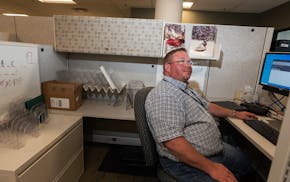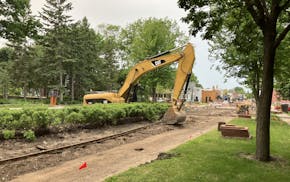Minnesota's law enforcement agencies have new guidance ensuring schools see more uniformity in how on-campus officers do their jobs.
Think of them not just as enforcers, but as mentors, too.
Training, too, is being standardized under a recently approved model policy that will help govern the work of the state's school resource officers, or SROs.
The blueprint was crafted over the summer and fall by a group of educators, student advocates and law enforcement officials, among them Golden Valley Assistant Police Chief Rudy Perez, a former Los Angeles police officer and past president of the National Association of School Resource Officers.
"This is a great opportunity — now that I'm a Minnesotan — to move forward in a great collaborative way," he said in a recent meeting of the state Board of Peace Officers Standards and Training (POST), which was charged by the state Legislature with coming up with the model guidelines.
Officers are expected to build positive relationships with kids and find alternatives, when possible, to placing students in the courts system. They are to be trained, too, in crisis intervention and ways to de-escalate disruptive and potentially violent behavior.
They still have the authority, however, under state law, to restrain students facedown in a prone position, if circumstances dictate. And that remains a concern among students and activist groups such as Solutions Not Suspensions, a coalition supporting anti-racist education.
It had been a short-lived ban on those so-called prone restraints that led agencies to pull SROs from schools a year ago due to liability concerns.
Khulia Pringle represented Solutions Not Suspensions in the group that drafted the model guidelines, and she said the policy did not go far enough to reduce the duration and use of prone restraints.
"Every child deserves to feel safe, valued and respected," said Pringle, who nonetheless described the policy overall as a "step in the right direction."
Local expectations
Law enforcement agencies also negotiate contracts with school districts and charter schools, and in the case of Rochester, the 10-page document makes clear at the start that the city and school district are committed to reimagining the role of cops in schools.
At John Adams Middle School last month, school resource officer Al Arzola walked the hallways with students — many clearly happy to see him — and he spoke of letting kids whose emotions are running hot and who feel a need to vent to take out their frustrations on him instead of their classmates.
He is determined, too, if students get into a fight, to do all he can to refer the case to a restorative justice center that works with the families of the offender and the victim to talk out what has occurred and find agreement on how to make things right.
Rochester also requires SROs to give presentations and create videos to promote school and community safety, and with a weekend fast approaching, Arzola's talk involved risks associated with social media.
Don't record fights, think hard about friend requests, and perhaps most importantly, he said, don't share inappropriate photos and videos.
"Can you do that for me, sixth graders?" Arzola asked. "Enjoy your Friday."
Wide-ranging training
The state has set a Jan. 15 deadline for the POST board and the Minnesota School Safety Center to outline "learning objectives" for the new training course — and it will cover a lot of ground.
Jenny Larrive, SRO coordinator for the safety center, already oversees a three-day training program with topics that include de-escalation strategies, a special education primer and the legal considerations that officers must take into account when they shift from patrolling streets to school campuses.
Consent to search laws, for example, are different in schools, she said.
At a session this summer, Dakota County Sheriff's Deputy Lucas Martin explained how he works to calm students who are sometimes nonverbal and sometimes violent.
The legislation calling for the standardized training and policy development also requires SROs to be taught on how to detect juvenile exploitation, the impact of childhood trauma on student behavior, and the legal standards guiding the use of force and the detention or arrests of students in school settings.
Last week, Larrive said her team and the POST board staffers are on the case and will deliver. "Our course will provide an excellent foundation for future school resource officers in Minnesota," she said.
In South Carolina, Walz says Democrats 'need to change the attitude'

After years at home, thousands of Minnesota state workers are about to return to the office

On the campaign trail, Elon Musk juggled drugs and family drama

Grand Avenue reconstruction unearths streetcar tracks, showing St. Paul's past
